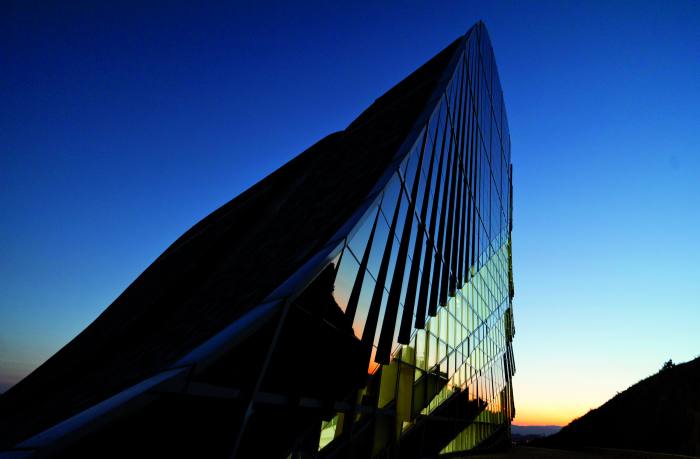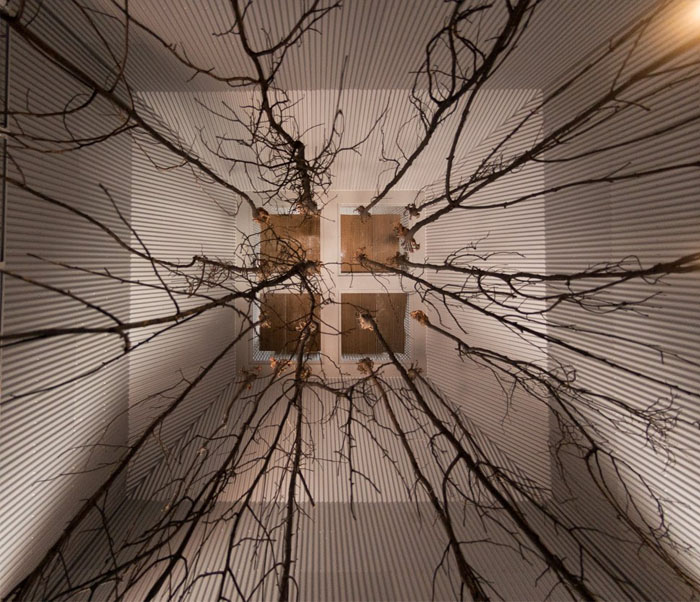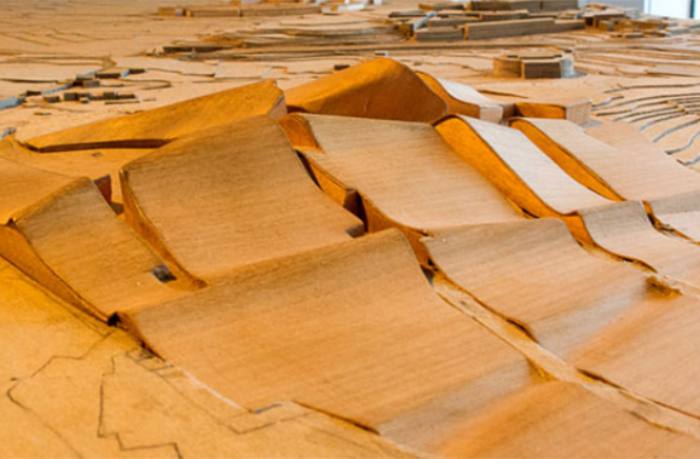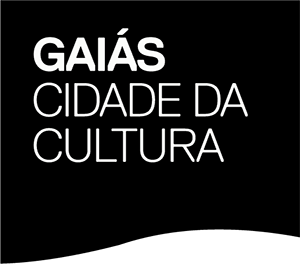
Gaiás
City of Culture
The City of Culture is one of the most interesting examples of contemporary architecture in northern Spain, a space with a powerful visual strength to enjoy creativity and nature. Designed by the North-American architect Peter Eisenman in Santiago, a World Heritage city and goal of the Way, the complex includes the Gaiás Centre Museum, the Library and Archive of Galicia, the Center for Entrepreneurship and the CINC building, dedicated to new technologies.
More Info: www.cidadedacultura.gal

Betula Pendula. Landscape intervention in the Hejduk Towers
The frailty of Galician forests made art. This is Martín Toimil’s idea for the landscape intervention Betula Pendula at the Hejduk Towers, in which he makes use of the dual character of these structures (glass-stone/transparent-opaque) in a play of opposites with which he wishes to reflect the reality of Galician woodlands. On the one hand, beauty, through the landscapes offered by its native species, such as birch. And on the other, the destruction, caused by the scourge of forest fires.
In this intervention based on confrontation, Martín Toimil -a graduate in Landscape Architecture from the Technical University of Lisbon- hangs birch trees in the glass tower and does the same in the stone tower. However, in the latter, he places trees burned during the last wave of forest fires suffered in Galicia. In both installations they hang upside down, emulating the profile of the elevation of the Hejduk Towers, since the gap between the two buildings is identical to the silhouette of an inverted tree.
In the glass tower, the birches are tied and suspended from the root balls, with an irrigation system installed to keep the trees alive. A mirror is set on the floor. In this manner, visitors are transported to the sensation of walking over the treetops.
Meanwhile, in the stone tower that houses the inverted burnt trees, as sculptures, the absence of light will be used and lighting installed to create shadows, projecting the sculpture throughout the interior.
MARTÍN TOIMIL
Martín Toimil Mato is an agricultural engineer graduated from the University of Santiago de Compostela. Since 2010, he is the director of the landscape architecture studio laND30, through which he develops his professional activity. Some of his works have been awarded several prizes in national and international competitions. O Xardín Celta was the winner at the 2013 World Landscape Art Exposition in Jinzhou, China. Nebula won the first prize in the international competition for the Marina Al Arab Urbanization in Dubai, submitted in collaboration with the architecture studio A-cero. Epigrafía obtained an honourable mention in the contest for Ideas for the Cloister of San Francisco at the Provincial Museum of Lugo in 2011, as well as the proposal for the refurbishment of Rua Frei Caneca in São Paulo, Brazil. Recently, Activar el Cráter, in collaboration with Iván Torres architects, was the winner of the ideas contest for the Playa Honda Urban Park in Lanzarote, in the Canary Islands. He also combines his professional work with outreach and teaching activities.
OTHER INTERVENTIONS AT THE HEJDUK TOWERS
The Hejduk towers are often the object of artistic interventions, in the case of Betula Pendula of a landscape nature, to become, in this way, an unconventional exhibition space that has hosted proposals by contemporary artists such as Pamen Pereira, Ana Soler, Alejandra Sampedro, Félix Fernández, Sonia Navarro and Irma Alvarez-Laviada.
The Hejduk Towers were designed by the American architect John Hejduk as a vertical greenhouse for the Belvís Park in Santiago. After Hejduk passed away, his friend Peter Eisenman decided to integrate them into the project of the City of Culture. Thus, they became one of the first elements to be built on Mount Gaiás. Visible from many points of Compostela, their visual strength grants them an iconic character, becoming one of the most representative symbols of the City of Culture.
Ever since they were opened to the public, the Hejduk Towers have welcomed proposals from modern artists and are connected to the Meeting of Young Artists ‘City of Culture of Galicia’, in which the participants are invited to take part in a contest of proposals to intervene in the towers. Precisely, the last intervention was that of Fredy Solano with A través dun horizonte sen corpo and the next one will be most recent winning project: ‘AAMA’ (Arquivo Aberto da Memoria Arquitectónica).
21 March - 19 August
8:00 to 20:00 hours
Hejduk Towers
Organised by: Foundation for the City of Culture of Galicia
Sponsor: Viaqua

Galicia Universal. Galician art in the collections of ABANCA and Afundación
Galicia Universal. Galician art in the collections of ABANCA and Afundación is the largest exhibition of artworks from the private collections of ABANCA and of Afundación ever to be assembled. Paintings, sculptures, photographs and installations make up this journey through two centuries of Galician art.
This exhibition displays an anthology of 192 pieces that range from the first third of the 19th century to the present time, which renders Galicia Universal. Galician art in the collections of ABANCA and Afundación the most ambitious recent exhibition of Galician art.
The collections of Galician art belonging to ABANCA and Afundación perfectly reflect the two factors that marked the construction of the Galician plastic arts since the 19th century: “identity” and “universality”. These two concepts address two unique elements to understand our art: the history of Galician culture and its link to the international context.
For the first time, one single exhibition brings together 119 of the most relevant Galician artists of the last 150 years, such as Jenaro Pérez Villaamil, Fernando Álvarez Sotomayor, Urbano Lugrís, Francisco Lloréns, Serafín Avendaño, Laxeiro, Virxilio Viéitez, Manuel Coléiro, Luís Seoane, Arturo Seoane, Maruja Mallo, Eugenio Granell, Julia Minguillón, Francisco Leiro, Antón Patiño, Menchu Lamas, Xaime Quessada, Berta Cáccamo, Antón Lamazares, Pamen Pereira, Elena Colmeiro and Antía Moure, among many others.
The ABANCA and Afundación collections are one of the most significant legacies of Galician art. Therefore, this joint exhibition enables us to experience the development of Galician plastic arts from the first half of the 19th century to the beginning of the 21st century, both within their national and international contexts. They are also proof that Galician art was not alien to the influences of the major art movements of the Old Continent at each time in history.
From March 16 to October 14, 2018 - 10:00 to 20:00 hours
Gaiás Centre Museum. Admission Free
Open from Tuesday to Sunday (open on Monday of Easter Week)
GUIDED VISITS:
- Tuesday to Friday: 5:30 p.m.
- Easter Week, summer months (July and August), Saturdays, Sundays and holidays: 12:30h and 17:30h
- Free admission. No reservation is necessary.
EDUCATIONAL VISITS:
- Starting on March 20.
- Directed to educational centres.
- Registration for schools and more information here.

Permanent exhibition of the architectural models and projects for the City of Culture
The Gaiás Centre Museum welcomes as a permanent exhibition the models of all the projects that were submitted in 1999 to the International Architecture Competition to build the City of Culture of Galicia on Mount Gaiás in Santiago de Compostela.
Twelve proposals by renowned national and international architecture teams were submitted to this competition for ideas, which eventually were eleven after the withdrawal of the project by Santiago Calatrava. The architects who contributed their ideas to define the architectural complex and its uses were Ricardo Bofill, Peter Eisenman, Manuel Gallego Jorreto, Annette Gigon and Mike Guyer, Steve Holl, Rem Koolhaas, Daniel Libeskind, Juan Navarro Baldeweg, Jean Nouvel, Dominique Perrault, and César Portela
Among all these ideas, the final project to be selected for development was the one designed by Eisenman Architects, as according to the Jury’s decision it was “unique both in concept and plasticity and exceptionally in tune with the site’s location”.
Guided visits
Discover the City of Culture in a guided tour in which to learn about the architecture of the complex designed by Peter Eisenman, its green spaces and its cultural offer.
Easter, July and August, from Tuesday to Sunday, special visit in English at 12
Departure from Gaiás Centre Museum
Free admission | Reservation not required
Group visits
English and Portuguese spoken
visitas@cidadedacultura.org | T. +34 881997584



Discover Gaiás
If you are currently planning what to do on your visit to Santiago de Compostela, there is one place to visit that's a must: the Galicia City of Culture. The complex designed by Peter Eisenman is one of the most striking examples of contemporary architecture. But that's not all. Art, culture, nature and gastronomy come together at the top of Mount Gaiás. To make sure you don't miss a thing, here is a short guide to enjoy all the possibilities the City of Culture has to offer.
Book ball. An enormous ball full of books welcomes visitors to the City of Culture. The name of the piece is Singularidad (Singularity), by the renowned visual artist Alicia Martín. Although it was originally installed as a temporary piece, it is now a symbol and a must-have photo for anyone who comes to Gaiás.
Model of Gaiás. Next to the 'book ball', the Eisenman Room invites us to discover the projects designed for the City of Culture, with models, plans and explanations by architects such as Jean Nouvel, Rem Koolhass, Ricardo Bofill, Manuel Gallego Jorreto and, of course, Peter Eisenman.
Library and Archive of Galicia. It is time to enter the Library and Archive of Galicia building. As well as visiting its incredible reading room, you can make the most and visit some of the temporary exhibitions presented with own funds of the institutions it houses.
.
Discover the Hejduk Towers. The Hejduk Towers are a must see. These are the first pieces to be erected in the City of Culture and the only ones that were not designed by Eisenman, but by the architect John Hejduk, who conceived them as botanical towers for Belvís Park. It currently hosts contemporary artistic interventions such as La línea Hejduk (the Hejduk line), an installation by Irma Álvarez-Laviada that you can visit until August.
Touching the sky in the central square. You cannot leave the City of Culture without trying to 'climb' the ramp up the Library and Archive of Galicia building, which you can access from the large central square. It's like touching the sky. But be very careful when you climb down.
A well-deserved rest at the Canteen. Are you tired? Do you need a coffee? Or something to eat? The Canteen at the City of Culture is the ideal place to take a break. The Canteen has won two awards at the prestigious Restaurant & Bar Design awards, recognising the best-designed restaurant in the world, and it offers a café service all day long, plus a short food menu and a full menu of the day.
A literary walk. When you've got your strength back, go to the heart of the City of Culture and enjoy a walk through the Literary Garden, a green space dedicated to Galician writers and poets. Paths running through verses by Pondal or Cunqueiro, beautiful views over Compostela and a small lake.
From the Tree to the Chair and Flor Novoneyra visit. The City of Culture is the perfect place to enjoy culture and art. And for that, nothing better than the Gaiás Centre Museum, with its spectacular façade and its height of 43 metres. Gaiás centre for artistic life, until November it hosts the free exhibition Del árbol a la silla (From the Tree to the Chair), an emotional journey through the forests to our homes, focusing on enhancing natural heritage and contemporary design. And, at the 3 floor, Flor Novoneyra, a pictorial testament by Anton Lamazares.
Rest in the Lake Park. Before you think about leaving, the City of Culture still has one last surprise: the Lake Park. A large green area with a network of footpaths, a lake covering 4,783 square metres surrounded by vegetation and a wooden platform at the edge equipped with rest areas.
Descent through the Forest of Galicia. If you still have the strength, the perfect way to leave the City of Culture is along the footpaths of the Forest of Galicia, Compostela's new green lung, 24 hectares with seven thousand trees of native species.



Practical Information
Visit the City of Culture
The City of Culture opens its doors to all the citizens that want to know the cultural complex designed by Peter Eisenman.
Visitors can have free access to the Museum, to the Archives and to the Library, as well as to the outdoor facilities, such as the Hedjuk Towers and the Central Plaza. Besides, there is a program of guided visits to the City of Culture that allows visitors to know the secrets of the architectonic project.
Opening hours
Daily | 8:00 - 23:00 | Private vehicles allowed
Tuesday to Sunday | 10:00 - 20:00 h. Closed every Monday
25 July. Open from 10 to 20 h.
Tuesday to Sunday | 08:00 - 20:00
Information point: Monday to Friday | 8:30 -14:30
Information point
Museum, Tel. +34 881 995 172
Tuesday to Sunday | 10:00 - 20:00
Guided visits
From June 22nd to September 30th 2016
Tuesdays-Sundays | 11:30 and 17:30
Departure from Gaiás Centre Museum
Free admisión | Reservation not required
Group visits
English and Portuguese spoken
visitas@cidadedacultura.org | T. +34 881997584
Buses from / to the town centre
LINE 9: Monday - Friday (working days) | Saturday morning
Departures from Casas Novas [Every 60 min.]
Monday to Friday 07:30 - 22:30 | Saturday 08:30 - 13:30
Departures from the City of Culture [Every 60 min.]
Monday to Friday 08:00 - 22:00 | Saturday 09:00 - 13:00
+info Urban transport, Line 9
LINE C11: Saturday afternoon | Sunday and bank holiday
Departures from Multiusos Fontes do Sar
Saturday 17:30 and 20:00
Sunday and bank holiday 10:40, 13:45, 17:25 and 20:05
Coordenadas GPS
Latitud 42º 52' 13.02" N
Longitud 8º 31' 32.69" W
